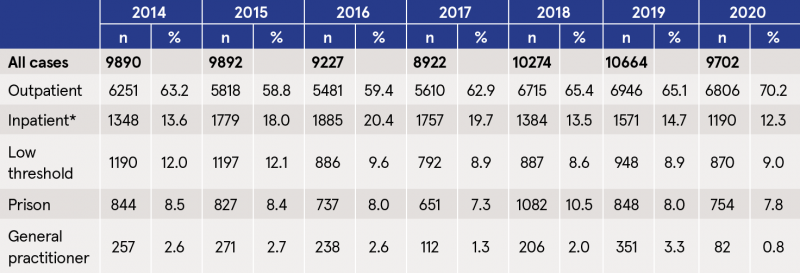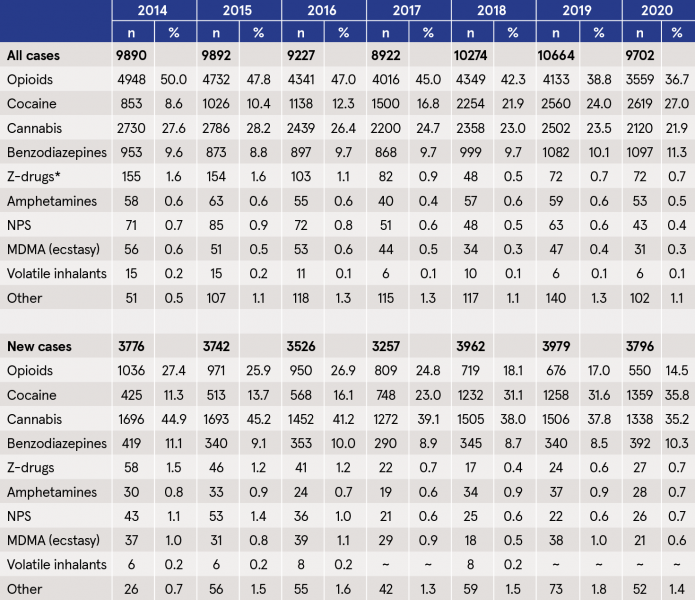Kelleher, Cathy (2021) Drug treatment in Ireland, 2014–2020. Drugnet Ireland, Issue 79, Autumn 2021, pp. 26-29.
| Preview | Title | Contact |
|---|---|---|
|
PDF (Drugnet Ireland 79)
1MB |
Published in July 2021, the latest National Drug Treatment Reporting System (NDTRS) report presents trends in treated problem drug use (excluding alcohol) for the seven-year period from 2014 to 2020.1,2
Key findings
Over the period, some 68,571 cases treated for problem drug use (excluding alcohol) were reported to the NDTRS.3 The number of treated cases recorded decreased from 9,890 in 2014 to 9,702 in 2020 (see Table 1). Between 2019 and 2020, the number of treated cases decreased by 9%, from 10,664 cases to 9,702 cases.
The overall drop in the number of cases entering drug treatment in 2020 is in part the result of temporary service closures and measures introduced to comply with Covid-19 restrictions and does not necessarily indicate a real decline in demand for treatment.4,5
New cases (never previously treated) accounted for 38.2% of cases in 2014 and 39.1% in 2020. Previously treated cases accounted for 57.1% of cases in 2014 and 56.1% in 2020.
In 2020, the majority (70.2%) of cases were treated in outpatient facilities (as in previous years), while 12.3% of cases were treated in inpatient facilities, 9% in low-threshold services, 7.8% in prisons, and 0.8% by general practitioners (see Table 2).6
Between 2019 and 2020, the number of cases treated in residential settings decreased by 24.3%, from 1,571 cases to 1,190 cases. The reduction in residential case numbers can in part be attributed to temporary closures and measures introduced to comply with Covid-19 restrictions.
Table 1: Number of cases treated for drugs as a main problem, by treatment status, NDTRS 2014–2020

Table 2: Number of cases treated for drugs as a main problem, by type of service provider, NDTRS 2014–2020

* Includes any service where the client stays overnight, e.g. inpatient detoxification, therapeutic communities, respite, and step-down.
Main problem drug
Opioids (mainly heroin) remain the main problem drug reported over the period. As a proportion of all cases treated, opioids decreased year-on-year from 50% in 2014 to 36.7% in 2020 (see Table 3).
Cocaine was the second most common main problem drug reported in 2020. The proportion of cases treated for cocaine as a main problem increased from 8.6% in 2014 to 27% in 2020.
Cannabis was the third most common main problem drug reported in 2020. The proportion of cases treated for cannabis as a main problem decreased from 27.6% in 2014 to 21.9% in 2020.
In 2020, cocaine (35.8%) replaced cannabis as the most common main problem drug among new entrants to treatment (see Table 3). Cocaine was followed by cannabis (35.2%) and opioids (14.5%). Among new cases, cocaine increased from 11.3% in 2014 to 35.8% in 2020.
Table 3: Main problem drug (excluding alcohol) reported in 30 days prior to treatment, NDTRS 2014–2020

Z-drugs are non-benzodiazepine hypnotic sedative drugs, e.g. zolpidem and zopiclone.
NPS: New psychoactive substances.
~ Cells with five cases or fewer.
Polydrug use
Over the period, the majority of cases (58%) reported polydrug use (i.e. problem use of more than one substance). The proportion of cases that reported polydrug use decreased from 59.6% in 2014 to 53.4% in 2018, then increased to 58.6% in 2020 (see Table 4).
In 2020, cannabis (39.5%) was the most common additional substance reported by cases with polydrug use, followed by cocaine (36.8%), benzodiazepines (36.5%), and alcohol (34.9%).
Table 4: Polydrug use in cases treated for drugs as a main problem, NDTRS 2014–2020

Risk behaviour
The proportion of all cases that had ever injected decreased from 35.7% in 2014 to 23.3% in 2020. Among cases that had ever injected, the proportion currently injecting (i.e. in the 30 days prior to treatment) decreased from 37% in 2014 to 31.1% in 2020.
Sociodemographic characteristics
The following sociodemographic characteristics of the cases were noted:
- Three in every four cases reported over the period were male.
- The median age of cases when entering treatment increased from 29 years in 2014 to 31 years in 2018 and has remained stable ever since.
- Under 18s accounted for 6.9% of cases in 2020.
- Cases recorded as homeless increased in proportion from 8.5% in 2014 to 10.5% in 2020.
- The proportion of cases with an Irish Traveller ethnicity was 3% in both 2014 and 2020.
- A large proportion of cases (59%) were unemployed in 2020, as in previous years.
- The proportion of cases in paid employment increased from 8.3% in 2014 to 16.2% in 2020.
Sociodemographic characteristics – cocaine as main problem
The following sociodemographic characteristics of cases with cocaine as a main problem were noted:
- Eight in 10 cases reported over the period were male.
- The proportion of female cases increased from 17.2% in 2014 to 20.8% in 2020.
- The median age of cases when entering treatment was the same in 2014 and 2020
(30 years). - Under 18s accounted for 2% of cocaine cases in 2014 and 1.7% in 2020.
- The proportion of cases in paid employment increased from 19.9% in 2014 to 30.2% in 2020.
- Cases with polydrug use decreased in proportion, from 70.2% in 2014 to 63.3% in 2020.
- In 2020, the most common additional substances were alcohol (53.9%), cannabis (49.8%), and benzodiazepines (31.7%).
1 The NDTRS is the national epidemiological surveillance system that reports on treated problem drug and alcohol use in Ireland. Established in 1990, the NDTRS is maintained by the National Health Information Systems (NHIS) of the Health Research Board (HRB) on behalf of the Department of Health.
2 Kelleher C, Carew AM and Lyons S (2021) National Drug Treatment Reporting System: 2014–2020 drug treatment data. HRB StatLink Series 6. Dublin: Health Research Board. http://www.drugsandalcohol.ie/34162
3 The data reflect the number of entries into treatment in a calendar year, rather than the number of persons treated in that year.
4 The capacity and functionality of treatment services were impacted by Covid-19 restrictions. The NDTRS surveyed participating services to estimate the impact of the restrictions on treatment data for 2020 (the response rate was 80%). Around 40% of services surveyed expressed some impact on their ability to provide returns, while around 50% expected some impact on numbers (unpublished data).
5 To comply with European Monitoring Centre for Drugs and Drug Addiction (EMCDDA) requirements and enable services to accurately reflect their activities in response to Covid-19 restrictions, the NDTRS added functionality to the LINK database to record treatment provided over the telephone or internet (teleworking).
6 Coverage of services was 71.1% for 2020. The number of services participating in the NDTRS varies annually, making small fluctuations in the numbers of cases difficult to interpret.
J Health care, prevention, harm reduction and treatment > Treatment and maintenance > Treatment factors
J Health care, prevention, harm reduction and treatment > Health care programme, service or facility
VA Geographic area > Europe > Ireland
Repository Staff Only: item control page